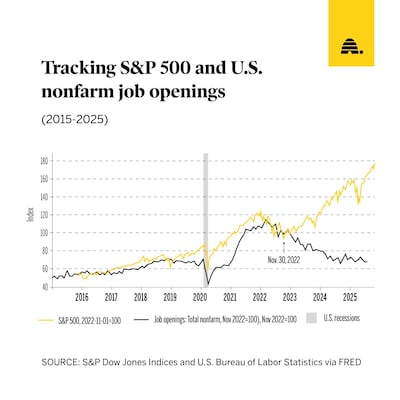Developer Offer
Try ImaginePro API with 50 Free Credits
Build and ship AI-powered visuals with Midjourney, Flux, and more — free credits refresh every month.
Is AI Driving The Stock Market And Stalling Jobs
The Viral Chart Sparking Economic Debate
Has ChatGPT fundamentally changed the American economy? A compelling graph, dubbed “The Scariest Chart in the World” by journalist Derek Thompson, suggests a massive shift. It highlights a startling divergence: since late 2022, job openings have plummeted while the stock market has soared. For two decades prior, these two metrics moved in sync.
This chart, circulating widely on platforms like Facebook and LinkedIn, pins the turning point on the public release of ChatGPT on November 30, 2022. The numbers are dramatic: according to Federal Reserve Economic Data, the stock market has climbed 80% since ChatGPT's launch, while job openings have dropped by about 33%.

However, the story this graph tells is far more complex than it first appears, with many experts pointing to other factors like federal policies and economic normalization.
Is AI Really The Culprit?
While it’s “not illogical” to connect this divergence to the rise of AI, not all economists are convinced, says Steven Kamin, a senior fellow at the American Enterprise Institute. He notes that many believe “the dissemination of AI just hasn’t gone far enough to lead to substantive job impacts.”
The data seems to support this skepticism. The sectors experiencing the biggest slowdown in job openings, such as “mining and lodging” and “durable goods manufacturing,” are not the ones most likely to be immediately replaced by large language models. Sam Rahman, a portfolio manager at Hedge Asset Management, also expressed doubt, stating, “They’re very different data sets, and I don’t think it’s as linked as the chart shows.”
A Closer Look at The Job Market
It's crucial to understand that a decline in job openings does not equal widespread job losses. Data from the Federal Reserve shows that job openings skyrocketed to unnatural highs following the COVID-19 pandemic. The recent drop can be seen as a normalization or cooling of a red-hot market. In fact, there are still more job openings today than at almost any point in the two decades before the pandemic.
Kamin suggests an alternative explanation: “the economy slowing in a context where businesses already had all the employees they needed.” At the same time, the stock market's growth is heavily concentrated in AI and tech companies. This surge reflects investor hope for future productivity gains, not necessarily current profitability from laying off workers.
Beyond AI: Other Economic Pressures
Several other policy-related factors are likely contributing to the hiring slowdown. Unpredictable tariffs, high interest rates, and stricter immigration policies all create uncertainty for businesses. Rahman explains that this unpredictability makes companies hesitant to add new workers, even if they aren't cutting their existing workforce. “They’re not adding new workers because of this uncertainty,” he said.
In a way, AI contributes to this hesitation. Employers are pausing to evaluate where human labor is essential and where AI could fill gaps. This strategic pause, combined with high interest rates that disincentivize investment and immigration laws that restrict labor supply, creates a complex environment for hiring.
Learning from Past Tech Revolutions
The AI revolution is unfolding differently than the dot-com boom. Jerod Wilkerson, a professor at Brigham Young University, recalls that when the World Wide Web was released publicly in 1993, its impact trickled out slowly. It was a tide that lifted all boats, creating new opportunities and jobs for developers and many others. The public wasn't worried about losing their jobs.
ChatGPT, by contrast, “changed the world almost instantly.” It reached one million users in five days and 100 million in two months. This unprecedented speed has fueled anxiety. Unlike the internet, which made education more valuable, AI seems to be devaluing certain cognitive skills, particularly in white-collar professions. Manual labor and service jobs face no immediate threat, but writers, analysts, and programmers are feeling the pressure.
The Future Workforce: Navigating The AI Shift
The rapid adoption of AI presents new challenges. If companies replace junior-level roles with AI, they risk creating a future talent gap. As Wilkerson notes, while AI is a powerful tool, it still requires expert oversight. “I correct it all the time, and I can’t just turn it loose and let it go build everything,” he explained. Without a pipeline of junior talent gaining experience, an “AI winter” could emerge, creating significant problems for the tech industry.
So, is AI already taking jobs? In some creative and coding-for-hire industries, yes. But Nancy Fulda, an AI researcher at BYU, offers a historical perspective. She points out that technology has always displaced jobs, from telephone operators to bank tellers. “Importantly, none of these changes heralded an incoming apocalypse,” Fulda said. “Human workers shifted into new roles, often more desirable roles.”
She believes the same pattern will emerge with AI. The key is to adapt, with a focus on ethical AI deployment and robust support systems for workers navigating this transition. As Fulda concludes, “I’m an optimist at heart. I believe it will all work out.”
Compare Plans & Pricing
Find the plan that matches your workload and unlock full access to ImaginePro.
| Plan | Price | Highlights |
|---|---|---|
| Standard | $8 / month |
|
| Premium | $20 / month |
|
Need custom terms? Talk to us to tailor credits, rate limits, or deployment options.
View All Pricing Details

